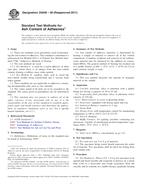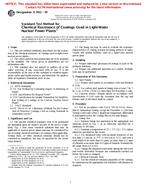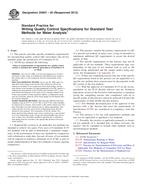Click here to purchase
1.1 These test methods cover the identification of the following textile fibers used commercially in the United States:
Acetate (secondary)Nylon
AcrylicNytril
AnidexOlefin
AramidPolycarbonate
AsbestosPolyester
CottonRamie
Cuprammonium rayonRayon (viscose)
FlaxSaran
FluorocarbonSilk
GlassSpandex
HempTriacetate
JuteVinal
LycocellVinyon
ModacrylicWool
Novoloid
1.2 Man-made fibers are listed in 1.1 under the generic names approved by the Federal Trade Commission and listed in Terminology D 123, Annex A1 (except for fluorocarbon and polycarbonate). Many of the generic classes of man-made fibers are produced by several manufacturers and sold under various trademark names as follows (Note 1):
AcetateAcele, Aviscon, Celanese, Chromspun, Estron
AcrylicAcrilan, Courtelle, Creslan, Dralon, Orlon, Zefran
AnidexAnim/8
AramidArenka, Conex, Kevlar, Nomex, Twaron
CuprammoniumBemberg
FluorocarbonTeflon
GlassFiberglas, Garan, Modiglass, PPG, Ultrastrand
LyocellTencel
ModacrylicDynel, Kanecaron, Monsanto SEF, Verel
NovoloidKynolPolyamide
(Nylon) 6Caprolan,Enka, Perlon, Zefran, EnkalonPolyamide
(Nylon) 6, 6Antron, Blue C, Cantrece, Celanese Phillips, Enka NylonPolyamide
(Nylon) (other)Rilsan(nylon 11), Qiana, StanylEnka,(Nylon 4,6)
NytrilDarvan
OlefinDurel, Herculon, Marvess, Polycrest
PolyesterAvlin, Beaunit, Blue C, Dacron, Encron, Fortrel, Kodel, Quintess, Spectran, Trevira, Vyoron, Zephran, Diolen, Vectran
RayonAvril, Avisco, Dynacor, Enka, Fiber 700, Fibro, Nupron, Rayflex, Suprenka, Tyrex, Tyron, Cordenka
SaranEnjay, Saran
SpandexGlospun, Lycra, Numa, Unel
TriacetateArnel
VinyonAvisco, Clevyl, Rhovyl, Thermovyl, Volpex
Note 1-The list of trademarks in 1.2 does not include all brands produced in the United States or abroad and imported for sale in the United States. The list does not include examples of fibers from two (or more) generic classes of polymers spun into a single filament. Additional information on fiber types and trademarks is given in References (1, 2, and 3).
1.3 Most manufacturers offer a variety of fiber types of a specific generic class. Differences in tenacity, linear density, bulkiness, or the presence of inert delustrants normally do not interfere with analytic tests, but chemical modifications (for such purposes as increased dyeability with certain dyestuffs) may affect the infrared spectra and some of the physical properties, particularly the melting point. Many generic classes of fibers are sold with a variety of cross-section shapes designed for specific purposes. These differences will be evident upon microscopical examination of the fiber and may interfere with the measurements of refractive indices and birefringence.
1.4 Microscopical examination is indispensable for positive identification of the several types of cellulosic and animal fibers, because the infrared spectra and solubilities will not distinguish between species. Procedures for microscopic identification are published in AATCC Method 20 and in References (4-12).
1.5 Analyses by infrared spectroscopy and solubility relationships are the preferred methods for identifying man-made fibers. The analysis scheme based on solubility is very reliable. The infrared technique is a useful adjunct to the solubility test method. The other methods, especially microscopical examination are generally not suitable for positive identification of most man-made fibers and are useful primarily to support solubility and infrared spectra identifications.
1.6 This includes the following sections:
SectionReferenced Documents2
Birefringenceby difference of refractive indices34, 35
Terminology3
Density24-27
Infrared Spectroscopy, Fiber Identification by17-23
Melting Point28-33
Microscopical Examination, Fiber Identification by9,10
Reference Standards7
Sampling, Selection, Preparation and Number of Specimens6
Scope1
Solubility Relationships, Fiber Identification Using 11-16
Summary of Test Methods4
Significant and Use5
1.7 This standard does not purport to address all of the safety concerns, if any, associated with its use. It is the responsibility of the user of this standard to establish appropriate safety and health practices and determine the applicability of regulatory limitations prior to use. See Note 3.
9.1 As previously mentioned this test method is useful for identification of various cellulosic and animal fibers and to distinguish man-made fibers form the cellulosic and animal fibers. Examine and observe the fiber characteristics as directed in the AATCC test method 20.
11.1 This test method covers the identification of fibers by determining their solubility or insolubility in various reagents and comparing these data to the known solubilities of the several generic classes of fibers. Other techniques (such as, microscopical examination or comparison of physical properties) are used to confirm the identification or to distinguish between those fiber classes (anidex, aramid, asbestos, fluorocarbon, glass, and novoloid) which are not dissolved by any of the reagents used in this scheme.
17.1 This test method covers identification of fibers by interpretation of an absorption spectrum from infrared spectrophotometric analysis of the homogenous specimen obtained by one of three techniques: potassium bromide (KBr) disk, film, or internal reflection spectroscopy.
Note 5-The internal reflection spectroscopy technique is more difficult to use satisfactorily than the KBr disk or film techniques and it is not recommended for use except by an operator experienced in the technique.
24.1 Fiber density is measured by density-gradient column method. Determine density by the density-gradient column, pycnometer, and a technique based on Archimedes’ principle as directed in the AATCC Test Method 20.
28.1 This test method allows determining the temperature at which the material begins to lose its shape or form and becomes molten or liquefies. Allowing material to reach its melting point results in permanent fiber change.
34.1 Refractive indices and birefringence are measured by Difference of Refractive Indices test method. Determine the refractive indices for plane-polarized light parallel to and perpendicular to the fiber length within 0.001, in accordance with AATCC Test Method 20.
Product Details
- Published:
- 08/01/2008
- Number of Pages:
- 14
- File Size:
- 1 file , 320 KB
- Redline File Size:
- 2 files , 630 KB


